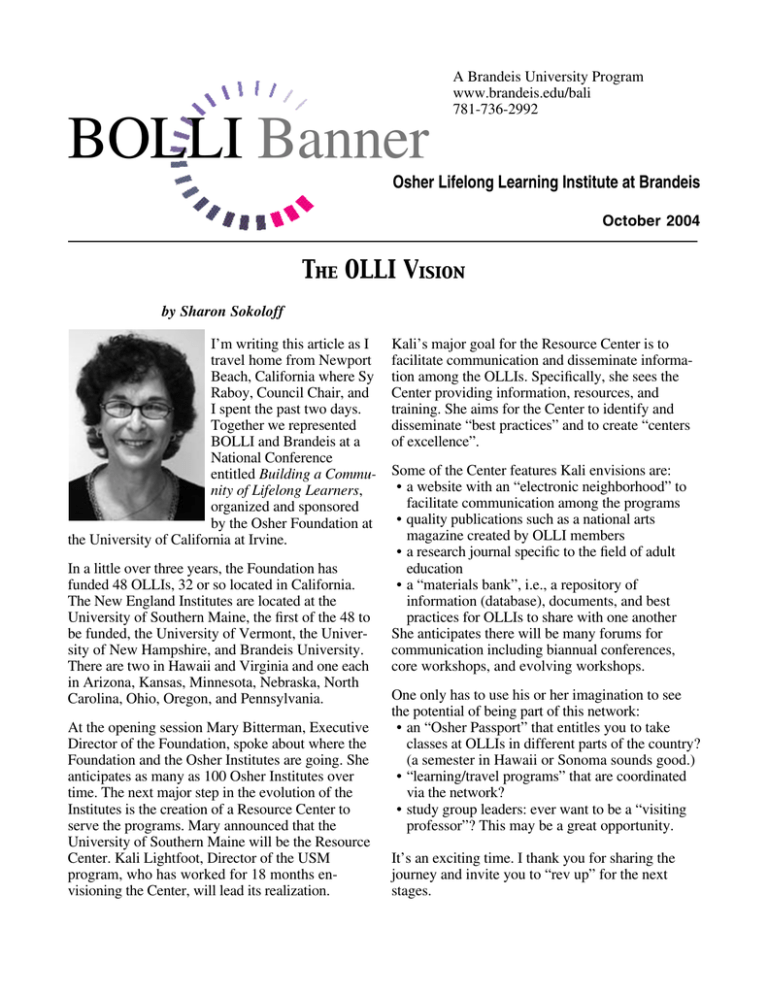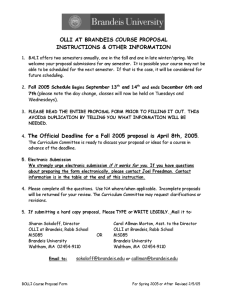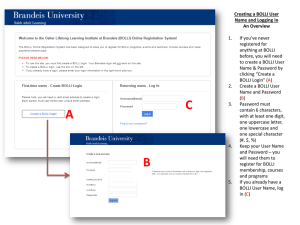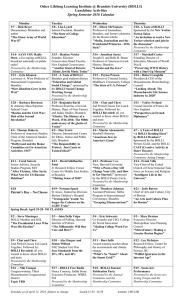BOLLI Banner T OLLI V
advertisement

BOLLI Banner A Brandeis University Program www.brandeis.edu/bali 781-736-2992 Osher Lifelong Learning Institute at Brandeis October 2004 The OLLI Vision by Sharon Sokoloff I’m writing this article as I travel home from Newport Beach, California where Sy Raboy, Council Chair, and I spent the past two days. Together we represented BOLLI and Brandeis at a National Conference entitled Building a Community of Lifelong Learners, organized and sponsored by the Osher Foundation at the University of California at Irvine. In a little over three years, the Foundation has funded 48 OLLIs, 32 or so located in California. The New England Institutes are located at the University of Southern Maine, the first of the 48 to be funded, the University of Vermont, the University of New Hampshire, and Brandeis University. There are two in Hawaii and Virginia and one each in Arizona, Kansas, Minnesota, Nebraska, North Carolina, Ohio, Oregon, and Pennsylvania. At the opening session Mary Bitterman, Executive Director of the Foundation, spoke about where the Foundation and the Osher Institutes are going. She anticipates as many as 100 Osher Institutes over time. The next major step in the evolution of the Institutes is the creation of a Resource Center to serve the programs. Mary announced that the University of Southern Maine will be the Resource Center. Kali Lightfoot, Director of the USM program, who has worked for 18 months envisioning the Center, will lead its realization. Kali’s major goal for the Resource Center is to facilitate communication and disseminate information among the OLLIs. Specifically, she sees the Center providing information, resources, and training. She aims for the Center to identify and disseminate “best practices” and to create “centers of excellence”. Some of the Center features Kali envisions are: • a website with an “electronic neighborhood” to facilitate communication among the programs • quality publications such as a national arts magazine created by OLLI members • a research journal specific to the field of adult education • a “materials bank”, i.e., a repository of information (database), documents, and best practices for OLLIs to share with one another She anticipates there will be many forums for communication including biannual conferences, core workshops, and evolving workshops. One only has to use his or her imagination to see the potential of being part of this network: • an “Osher Passport” that entitles you to take classes at OLLIs in different parts of the country? (a semester in Hawaii or Sonoma sounds good.) • “learning/travel programs” that are coordinated via the network? • study group leaders: ever want to be a “visiting professor”? This may be a great opportunity. It’s an exciting time. I thank you for sharing the journey and invite you to “rev up” for the next stages. Clifton Reed: Never A Quitter by Carol Shedd After 16 years as a pilot in the United States Air Force, three years teaching math and science in local high schools, and 17 years working for the Massachusetts Department of Education setting up vocational schools around the state, Clifton Reed is enjoying his retirement teaching courses at HILR and at BOLLI. Clift was leading study groups at HILR when he was persuaded by former BALI council member Rhoda Sapers to come to Brandeis. For the last five years he has been leading study groups at both institutions. script and the reality of the situations portrayed. Films in the syllabus range from Birth of a Nation through the silent films and later talkies of Oscar Micheaux, the giant of “race” movies, to the more recent movies of African-Americans like Sidney Poitier. In discussion, Clift will point out things the class may have overlooked, but which directors like Micheaux used to bolster the confidence and pride of the African-American viewer — something as simple as pictures of African-American heroes hanging on the wall in the background. In the silent film Body and Soul, Paul Robeson, a handsome dark-skinned man, portrays twin brothers: a good upright citizen and a villainous drunken pastor. As well as film stars and historical figures, Clift introduces the class to lesser-known people who were very important in the southern Black comClift’s agenda in teaching is to keep a focus and munity of the 1930s and 40s. One of these was awareness on what he wants to bring to the class from his knowledge growing up in pre-World War Julius Rosenwald. He and his brother Arthur were II Tennessee. His teachers in the segregated educa- responsible for the Sears Roebuck catalogs which were found in almost every African-American tional system imparted a mental toughness in their home. The Rosenwald brothers fed a portion of students that prepared Clift to move into and comtheir profits into matching fund grants to pete in the larger world. It is with this establish schools in black neighborhoods. background that he leads study groups on CLASSROOM People purchased happily from Sears and the history, literature, art, and music of the African-American. “People come to class HIGHLIGHTS Roebuck, and many swore up and down that the brothers must be Black! with preconceived notions. I take what they bring without confrontation and try to expand In his 1945 high school yearbook, Clift’s chosen on it.” motto is, “A quitter is never a winner. A winner is never a quitter.” Let us hope that it is a long time In this semester, Clift is leading the study group before Clift ‘quits’ as a BOLLI study group leader, African-Americans in the Movies: Art and and that he continues to bring his experiences and Propaganda”. The class discusses themes, knowledge to our membership in the courses he stereotypes, class and color issues, and standards leads. for evaluating films such as the integrity of the The BOLLI Banner is published by the Banner Editorial Committee: Richard Glantz, Publisher Tamara Chernow, Co-Editor Carole Grossman, Co-Editor Carol Shedd, Secretary Charles Raskin Katherine Raskin Leona Curhan, Council liaison Email us at: BALIBanner@aol.com Len Heier, Photographer Vol 5 Number 2 -2- October 2004 Medical Decision Making by Rhoda Sapers, RN, MSN I have a dear friend, a brilliant man, not reticent in any other aspect of his life, who recently had x-rays and other tests. When asked why he had the tests, his answer was “because the doctor told me to”. He didn’t have a clue what the physician was looking for, yet submitted to a battery of tests. The days are gone when one should turn over medical care without asking questions. We need to be more diligent and not give in to the fear of hurting the doctor’s feelings or being intimidated by not knowing what or how to ask. Now, more than ever, we need to come to the office full of questions in order to understand the issues. Pressure on physicians to see many patients in a shorter time span finds them less able to gather all the facts, spend time teaching us, and following up. We are expected to put the pieces together and make serious — even life saving — decisions. Some of the following suggestions will help us be more prepared advocates, realizing that physicians can’t be expected to be all-knowing. • During a medical visit it is helpful, perhaps necessary, to have someone with you. A second set of ears will aid in understanding or interpreting the conversation. When under stress, it is difficult to grasp information. It is critical to ask the pertinent questions during the visit in order to make the expected informed decisions. That time may be the most propitious moment you will have with your doctor. • We often want or need test results before they “come up”on the doctor’s computer screen. More often than not those results are available by the next day but we may be put off because the physician is too busy to access the results quickly. Someone in the doctor’s office may need to be urged to pursue results. In other words, don’t sit back if anxiety is overtaking you. • Always bring pertinent medical records, radiology films, or x-ray reports with you, whether or not the person making your appointment has requested them. It saves time and helps with assessment. Doctors and hospitals do not have direct access to records from other institutions. Bringing a list of your current medications is also helpful. TO YOUR GOOD HEALTH • Do not hesitate to request to see a specialist. They are usually more experienced with the most current approaches. That holds true for second opinions. Insurance companies expect that request. Hurting the doctor’s feelings is no reason to be reticent. They usually understand. • Take advantage of hospital Learning Centers such as www.massgeneral.org/pflc/ and www.bidmc.harvard.edu/, which provide a myriad of literature, access to computers, and trained people to assist you. Your own Internet searches can also be very helpful. In the end, though a medical degree may not be conferred upon you, informed you’ll be and more comfortable with your decisions. Congratulations to the Curriculum Committee and to the Lunch-and-Learn Committee, whose great work has led to the highest number of members in our history! Vol 5 Number 2 -3- October 2004 Downloading Email Attachments by Len Heier and Sherm Okun In our last article (May 2004), we TECH discussed sending and receiving “attachments”. Now we’ll focus on what TALK happens after an attachment is received — a problematic aspect of email. We will discuss what to do after you receive an attachment that you cannot “download”; i.e., move to your desktop and/or open it to view or print. Many Windows and Macintosh PCs are sold with a pre-installed copy of the Microsoft Office Suite (i.e., Word, Excel and PowerPoint) which provides the ability to open most major document formats including those created by competing products. One exception is the pdf format, which requires a free “download” of the Adobe Reader® software from the Adobe Website, www.adobe.com. Remember that an attachment is any computer file accompanying an ordinary text email message. These files may be word processing documents, photographic images, spreadsheets, computer programs, or any file from a computer. Every attachment has a particular “format”, which is a specific arrangement or organization of data established by a computer application (or digital camera). Normally, you cannot use an attachment unless your computer has a program that “understands” its particular format! Sometimes this program must be identical to the one that created the file, but often programs are capable of interpreting a variety of formats created by different programs. The common image formats are: jpg Joint Photographic Expert Group gif Graphic Interchange Group bmp bitmap (common for Windows) pic picture (common for Macintosh) psd Photoshop. Virtually all computers sold within the past five years provide facilities for viewing these formats. However, for psd you will need Photoshop, Photoshop Elements, or one of several thirdparty image-viewing programs. Although there are literally hundreds of different formats in common use, nearly all attachments are defined by a relatively few common categories, namely “documents”, “images”, and “compressed” formats. A file normally identifies its format to you and your computer by its “extension” (i.e., suffix) which is usually a dot plus the last three characters of the file’s name. These extensions are usually added automatically for Windows systems, but may have to be entered manually for Macintosh systems. The most common documents formats are: doc word processing txt unformatted text pdf Adobe portable document ppt PowerPoint presentation xls Excel spreadsheet. Vol 5 Number 2 Another important attachment type combines one or more files into a single file which is squeezed down (compressed) to as little as 10% of its original size. The most typical compressed file types are: zip (WinZip – common for Windows) and sit (Stuffit – common for Macintosh). You will need a program to decompress these files. There are many Internet sources from which free or trial versions can be acquired. In general, if you are unable to view or use an attachment, it will be because you do not have appropriate software for the file in question. If possible, ask the sender to try sending the file in a different format. Otherwise, you will have to acquire the appropriate software or move the file to another computer which can “open” that particular file type. Our next article will include information about viruses, which may reside in an attachment. -4- October 2004 Museums on the Web by Tamara Chernow Anyone who has been to Paris and the Louvre knows that it would take at least a month of visits to really do justice to one of the world’s finest art museums. If you can’t spare that much time, you can get a head start by taking a virtual tour of the museum on the web. First get a feel for the general architecture and grandeur of the galleries, and then proceed for a closer look at the works of art. LOCATION! Go to www.louvre.fr and after a few seconds you will have the opportunity to click on “English”. Then click on “virtual tour” on the LOCATION! menu on the left. After touring the various galleries, click on “selected works” to see close ups and descriptions of some of the collection. LOCATION! Check out The National Gallery of Art in Washington www.nga.gov to view highlights of their collection, slide shows with narration, and the kids’ page with wonderful activities centered on art works to show your grandchildren. Visit the Metropolitan Museum of Art at www.metmuseum.org and preview their current Byzantium exhibit. Take a virtual tour of the Hermitage Museum in St. Petersburg at www.hermitagemuseum.org and view their fantastic 3-D images. BOLLI Adventures On October 1st, 38 BOLLI Adventurers assembled at the DeCordova museum in Lincoln for a double treat. Divided into small groups, we visited the main gallery and toured The Architect’s Brother, a photography exhibit. Accompanied by docents, we studied the unusual approach of Robert and Shana ParkeHarrison, who employ paper negatives and collage to tell emotional stories of land destroyed by technology and overuse. Again with knowledgeable docents, we toured the museum’s glorious modern and contemporary sculpture garden, before adjourning to lunch at a delightful neighboring French restaurant. photo by Eileen Mitchell Vol 5 Number 2 -5- October 2004 Computer Bar The Technology Committee is delighted with the response of the membership to the “Computer Bar” which was initiated in September. Many of you stopped by and took the opportunity to learn how to access the Calendar, the website, and the class eboards. You were surprised to find the names and addresses of the membership just a click away. You found lists of special events on the calendar, and you found your homework assignments on eboards. The most often heard comment was, “This is simple”. The committee intends to make computers (Macs and PCs) available every Wednesday and Thursday for the rest of the semester. Please come as often as you like. We will facilitate your use of the computer in any way we can. Feel free to help each other or experiment alone. BOLLI begins earlier next term February 23, 2005 The University requested we start two weeks earlier than before so that our classes would not interfere with setting up Gosman for graduation ceremonies. Cartoon by Bob Russo “Sorry Spencer, they changed the name to BOLLI. I guess your $25 didn't cut it!!” Vol 5 Number 2 -6- October 2004 Main & Moody by the Banner staff Waltham has become a mecca for dining — fine dining, ethnic dining, fun dining — with most of its 100+ restaurants on Moody Street or Main Street. Since as a BOLLI member you are in Waltham at least once a week, we would like to introduce you to our favorites. LET THE GOOD TIMES ROLL Campania Trattoria 504 Main St., 781-894-4280 You know you are in a gourmet establishment when you stop talking to your dinner partner and slow your eating pace to allow you to savor one forkful at a time. Reservations must be made at least a few days in advance. Absolutely incredible! Carambola 663 Main St., 781-899-2244, www.carambola.com A sister restaurant of Elephant Walk in Boston and Cambridge, Carambola serves family-style Cambodian food. Their dishes are beautifully presented and offer a fresh change from other Asian cuisines, with “new” (to us) flavors. Regular or Tasting menus available at dinner. Erawan of Siam 469 Moody St., 781-899-3399 A fine dining experience combining imaginative dishes with good service, pleasing decor, and tables far enough apart to feel your conversations are private. All that, coupled with the carved vegetables for which the Thai are famous, make this place a real treat. Lizzy’s Ice Cream Parlor 367 Moody St., 781-893-6677, www.lizzysicecream.com 35 flavors of homemade delicious ice cream, frozen yogurt, and sorbet and their own hot fudge. Several “adult flavors” are featured, including Armagnac and French Plum. Try their espresso bar and “light meal menu”. Margaritas 227 Moody St., 781-893-9990, www.margs.com Guadalajara-style Mexican restaurant with traditional food, music, and furnishings. You can try the combinación de la casa if you can’t decide between burritos, enchiladas, or tacos. And don’t forget to sample one of their ten varieties of margaritas. New Mother India 336 Moody St., 781-893-3311, www.newmotherindia.com Offers an outstanding weekday lunch buffet from 11:45 A.M. to 3:00 P.M., for $6.95. All the food is fresh and preservative-free. Choose from an assortment of soups, salad, and Northern Indian dishes. An excellent choice for vegetarians and those watching their weight. Tom Can Cook 374 Moody St., 781-891-6977 Tasty Asian food in a simple setting. The name derives from a bet made to the chef that he couldn’t cook anything but Thai food. Tom wins the bet. Tuscan Grill 361 Moody Street, 781-891-5486 Rustic, casual, often crowded, and sometimes noisy, the Tuscan Grill serves exceptionally creative Northern Italian food. Homemade pastas, spit-roasted meats, and tempting desserts. Reservations advised. Wright Seafood 699 Main St., 781-899-7292 Generous portions of good seafood at a budget price. Ho-hum decor. Quite popular — expect long lines on Friday evenings. Vol 5 Number 2 -7- October 2004 Calendar of Campus Events compiled by Charles Raskin SLOSBERG RECITAL HALL 781-736-3331 Nov. 20 (8 P.M.) University Chorus and Chamber Choir James Olesen, conductor Majestic works from the classic choral repertoire Nov. 7 (3 P.M.) Brandeis-Wellesley Orchestra Neil Hampton, conductor Inspired performances of classics and world premieres. Concert includes Lili Boulanger’s tone poem D’un Main de Printemps and the Franck D Minor Symphony Nov. 21 (3 P.M.) Wind ensemble J. Darren Maule, conductor Powerful performances of works for brass and winds WEDNESDAY CONCERTS AT NOON Rapaporte Treasure Hall, Goldfarb Building Nov. 3 A mini-concert by the Lydian String Quartet ROSE ART MUSEUM 781-736-3434 Tantoori Satori & Commonplace 28 paintings and 40 watercolors by Italian painter Francesco Clemente. His work combines symbols of mysticism and folklore with images of everyday experiences from both his native Italy and his adopted homes in India and New York. Nov. 1 – Dec. 12 Tide Table Recently acquired by The Rose, South African artist William Kentridge contemplates for the first time the devastating impact HIV and AIDS have had on his country. Admission is $3. The Empty City Artist Yun-Fei Ji presents his view of the displaced inhabitants and environmental destruction of China’s Three Gorges Dam project, which will be completed in 2009. The artist employs traditional Chinese inkpainting techniques in 10 paintings and 25 preparatory sketches. WOMEN’S STUDIES RESEARCH CENTER (Epstein Hall, 515 South St.) 781-736-8102 Lecture Series Nov. 2 (12:30 P.M.) Ludmila Shern: A Jew or a Helen Nov 16 (12:30 P.M.) Annabel Beerel: Women and Power Nov. 4 (12:30 P.M.) Elizabeth Mark: Reclaiming the Torah’s Multiculturalism Nov 18 (12:30 P.M.) Naomi Myrvaagnes: A Fiction Reading Nov 23 (12:30 P.M.) Margaret Gullette: Improving Sexuality Across the Life Course Nov 9 (12:30 P.M.) Rhoda Unger: Women in Japan Vol 5 Number 2 -8- October 2004



